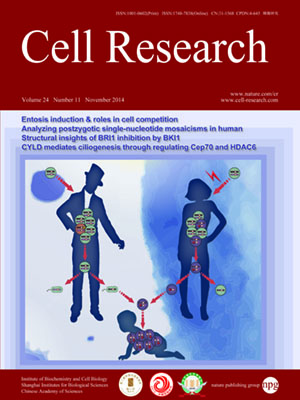Volume 24 Issue 11, November 2014: 1311-1327 | Open Access
ORIGINAL ARTICLES
Postzygotic single-nucleotide mosaicisms in whole-genome sequences of clinically unremarkable individuals
August Y Huang1,2,*, Xiaojing Xu3,*, Adam Y Ye2,4,5,*, Qixi Wu1,*, Linlin Yan2, Boxun Zhao1,6, Xiaoxu Yang2, Yao He1,2,4,5, Sheng Wang1, Zheng Zhang1,2,4,5, Bowen Gu1, Han-Qing Zhao2, Meng Wang2, Hua Gao2, Ge Gao2, Zhichao Zhang3, Xiaoling Yang3, Xiru Wu3, Yuehua Zhang3 and Liping Wei1,2
1National Institute of Biological Sciences, Beijing 102206, China
2Center for Bioinformatics, State Key Laboratory of Protein and Plant Gene Research, School of Life Sciences, Peking University, Beijing 100871, China
3Peking University First Hospital, Peking University, Beijing 100034, China
4Peking-Tsinghua Center for Life Sciences, Beijing 100871, China
5Academy for Advanced Interdisciplinary Studies, Peking University, Beijing 100871, China
6Graduate School of Peking Union Medical College, Beijing 100730, China
Correspondence: Liping Wei, E-mail: weilp@mail.cbi.pku.edu.cn; Yuehua Zhang,(zhangyhd@hotmail.com)
Postzygotic single-nucleotide mutations (pSNMs) have been studied in cancer and a few other overgrowth human disorders at whole-genome scale and found to play critical roles. However, in clinically unremarkable individuals, pSNMs have never been identified at whole-genome scale largely due to technical difficulties and lack of matched control tissue samples, and thus the genome-wide characteristics of pSNMs remain unknown. We developed a new Bayesian-based mosaic genotyper and a series of effective error filters, using which we were able to identify 17 SNM sites from ~80× whole-genome sequencing of peripheral blood DNAs from three clinically unremarkable adults. The pSNMs were thoroughly validated using pyrosequencing, Sanger sequencing of individual cloned fragments, and multiplex ligation-dependent probe amplification. The mutant allele fraction ranged from 5%-31%. We found that Cright arrowT and Cright arrowA were the predominant types of postzygotic mutations, similar to the somatic mutation profile in tumor tissues. Simulation data showed that the overall mutation rate was an order of magnitude lower than that in cancer. We detected varied allele fractions of the pSNMs among multiple samples obtained from the same individuals, including blood, saliva, hair follicle, buccal mucosa, urine, and semen samples, indicating that pSNMs could affect multiple sources of somatic cells as well as germ cells. Two of the adults have children who were diagnosed with Dravet syndrome. We identified two non-synonymous pSNMs in SCN1A, a causal gene for Dravet syndrome, from these two unrelated adults and found that the mutant alleles were transmitted to their children, highlighting the clinical importance of detecting pSNMs in genetic counseling.
10.1038/cr.2014.131
FULL TEXT | PDF
Browse 2168


